Table of Contents[Hide][Show]
- Why Is The Adventures of Prince Achmed Important?
- Lotte Reiniger: The Origins Of Animation Innovator
- A Fresh Take On The Classic Tales From The Arabian Nights
- What Animation Techniques Were Used In The Creation Of The Adventures Of Prince Achmed?
- Making Animation History
- Controversy & Censorship
- Restoration & Legacy
- Where Can I Watch The Adventures Of Prince Achmed?
- Cast & Crew
- The First Animated Movie Of All Time
The Adventures of Prince Achmed (Die Abenteuer des Prinzen Achmed) is a mesmerizing, but rarely-seen, 1926 animated feature by the amazing female German animator Lotte Reiniger. Considered to be the first full-length animated film, the movie’s plot is based on the Middle Eastern book of stories, The Arabian Nights. This color-tinted marvel utilizes laboriously cut-out silhouettes to create its enchanting narrative. Here’s what you need to know about this historic and influential animated film.
Why Is The Adventures of Prince Achmed Important?
- Reiniger made the entire film frame-by-frame with elaborate cardboard cutouts and camera.
- It is the oldest surviving feature-length animated film and predates Disney animations.
- Her ability to use cardboard silhouette marionettes to not only tell a story but evoke emotion will blow your mind.
- Lotte Reiniger was only 23-years-old when she created the film.
- The film boldly introduced one of cinema’s earliest depictions of a gay romance.
Nearly a century ago, a pioneering German filmmaker created the first animated feature-length film. Overflowing with colorful visuals and produced through painstaking effort, Lotte Reiniger’s film is still one of the most beautifully styled works of animation ever created.
Even though the film uses silhouette animation, it is colorful, gorgeous, and packed with imaginative elements like a magical flying horse, a sorcerer’s army of monsters, and of course, an alluring princess.
How did a 23-year-old craft animation’s first full-length film using intricate silhouette puppets and delicate backlighting techniques? Why did it take her three years to meticulously produce the film frame by frame? And how does Prince Achmed continue influencing animators and portraying Arab identity today? Here’s the story behind the movie that brought handmade paper cutouts to the silver screen.
Lotte Reiniger: The Origins Of Animation Innovator
Lotte Reiniger was born in 1899 in Berlin, Germany. As a child, she became fascinated with Chinese silhouette puppetry and was later heavily influenced by Germany’s lively avant-garde scene. Reiniger soon began experimenting with her own style of puppetry by making elaborate silhouettes that she animated at home and gave to friends and family members as gifts.
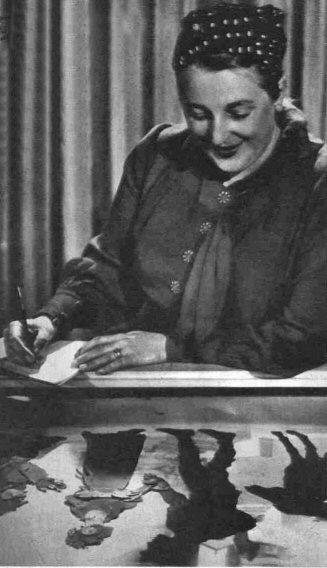
“I could cut silhouettes almost as soon as I could manage to hold a pair of scissors,” Reiniger recalled in an interview with Sight & Sound in 1936. “I could paint, too, and read, and recite; but these things did not surprise anyone very much. But everybody was astonished about the scissor cuts, which seemed a more unusual accomplishment. The silhouettes were very much praised, and I cut out silhouettes for all the birthdays in the family. Did anyone warn me as to where this path would lead? Not in the least; I was encouraged to continue.”
Reiniger also studied acting at The Institute of Cultural Research in Berlin. There she connected with several influential professionals including actor Max Reinhardt and directors Fritz Lang and F.W. Murnau. Most significantly, she met future husband Carl Koch, a filmmaker who helped produce her silhouette shorts. Though she continued to act as a hobby, Reiniger almost exclusively devoted herself to the art form of animation.
By 1919, Reiniger made her first silhouette short film. Inspired by Georges Méliès fantasies, she created several shorts throughout the early 1920s. Attaining global acclaim for her creative style, she drew interest from avant-garde collaborators who wanted to help finance her first feature film.
A Fresh Take On The Classic Tales From The Arabian Nights
With Koch co-directing, Reiniger ambitiously chose to adapt a popular collection of Middle Eastern folktales for her first film. Rooted in the tales of The Arabian Nights, “The Adventures of Prince Achmed” follows a young prince on a journey to rescue a princess, intertwining with characters like Aladdin and the Witch of the Fiery Mountains.
But those familiar with One Thousand and One Nights (aka Arabian Nights) won’t recognize the story of The Adventures of Prince Achmed. Reiniger didn’t directly adopt a particular tale from Arabian Nights. Instead, she chose to gather inspiration from the collection and ingeniously built her own original plotline.
The film tells a magical story of an evil African sorcerer who tricks a young prince named Achmed into riding a wild magical flying horse which he doesn’t know how to control. The evil sorcerer assumes that the Prince will eventually get thrown from the flying horse and plunge to his death. However, Prince Achmed manages to tame the flying horse and instead gets whisked away on a series of adventures that include encounters with Aladdin, the Witch of the Fiery Mountains, the beautiful Princess Pari Banu and of course a showdown with the evil African sorcerer.
What Animation Techniques Were Used In The Creation Of The Adventures Of Prince Achmed?
Preparing to visualize Arabian Nights through silhouette puppetry, Lotte Reiniger, Koch, and a small team, including iconic experimental filmmakers Walter Ruttmann and Berthold Bartosch, built an animation studio inside a tiny attic.
Together, they created tools for Reiniger’s animation process. Materials as simple as cardboard, sand, paint, and soap took on magical properties in their animation studio. Reiniger’s team even created an early multiplane camera stand with moveable layers, a technology that Walt Disney would later use for his animated films.
One of the things that makes this film so remarkable, is the animation technique used by Reiniger. Unlike typical cartoons that used a pencil on paper flip book approach, The Adventures of Prince Achmed uses a silhouette animation technique which involves the manipulation of cardboard cutouts and thin sheets of lead under a camera and color paints.
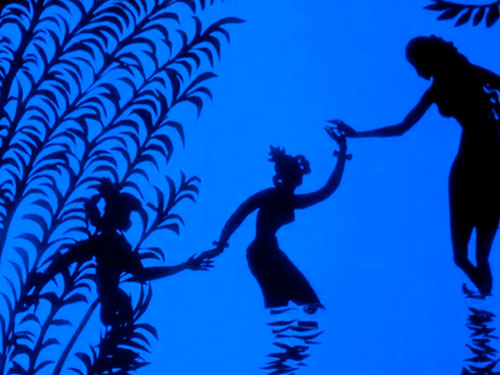
With up to 24 individual frames shot per second, each scene in the film required painstaking effort. Like a flipbook, thousands of still frames of film helped produce illusions of movement. Reiniger would subtly shift silhouette components frame-by-frame with tweezers and wires.
When asked how exactly she animated her film by the British magazine Sight & Sound in 1936, Reiniger had this to say:
“…The technique of this type of film is very simple. As with cartoon drawings, the silhouette films are photographed movement by movement. But instead of using drawings, silhouette marionettes are used. These marionettes are cut out of black cardboard and thin lead, every limb being cut separately and joined with wire hinges. A study of natural movement is very important, so that the little figures appear to move just as men and women and animals do. But this is not a technical problem. The backgrounds for the characters are cut out with scissors as well, and designed to give a unified style to the whole picture. They are cut from layers of transparent paper.”
Lotte Reiniger, Sight & Sound (1936)
If you are involved in the animation or film industry, then Lotte’s ability to use silhouette marionettes to not only tell a story, but evoke emotion, will blow your mind. Every moment was created frame by frame. From 1923 to 1926, it took three full years to finish shooting the 65 minutes of footage that would become The Adventures Of Prince Achmed. Each second of the film representing up to 1,440 incremental movements. That amounts to well over 50,000 frames manipulated by hand.
Making Animation History
After its release in 1926, The Adventures of Prince Achmed drew wide acclaim for its artistic animation innovations. Critics hailed it as the first animated feature film ever created. For perspective, legendary animation pioneer, Walt Disney, wouldn’t release his first feature film, Snow White And The Seven Dwarfs, until 1937, a full decade after the debut of Prince Achmed.
Reiniger’s groundbreaking movie was screened across the globe, significantly influencing experimental animators with its visual poetry in motion. It also inspired new types of multiplane animation and silhouette techniques still practiced today.
Controversy & Censorship
Prince Achmed is considered groundbreaking not just for its animation, but for also boldly depicting one of cinema’s first same-sex kisses. The film features a brief romantic kiss between the Emperor of China and a male character named Ping Pong.
When asked why she included the scene in the film, Reiniger explained: “I knew lots of homosexual men and women… and saw how they suffered from stigma.” Hoping children viewing Prince Achmed “would see it as a natural occurrence,” her sensitive portrayal aspired to normalize queer relationships. A remarkably progressive task for a 1920s animated film.
Restoration & Legacy
Despite the critical success of The Adventures of Prince Achmed, archival prints were lost the film’s original color tinting, a key aesthetic component, faded due to improper storage. Fortunately, German and British archivists were able to restore the film using its surviving nitrate prints. They were also able to digitally reintegrate the tinting process and repair damaged sequences.
This painstaking resurrection recreated Prince Achmed’s initial vivid hues, meaning new audiences could again appreciate Reiniger’s animation achievement just as audiences first saw it in the 1920s.
NERD NOTE: No original German nitrate prints of the film are known to still exist. They were likely lost during World War II. While the original film featured color tinting, prints available just prior to the restoration had all been in black and white. Working from surviving nitrate prints, German and British archivists restored the film including adding back the original tinted backgrounds of delicate pastels.
Where Can I Watch The Adventures Of Prince Achmed?
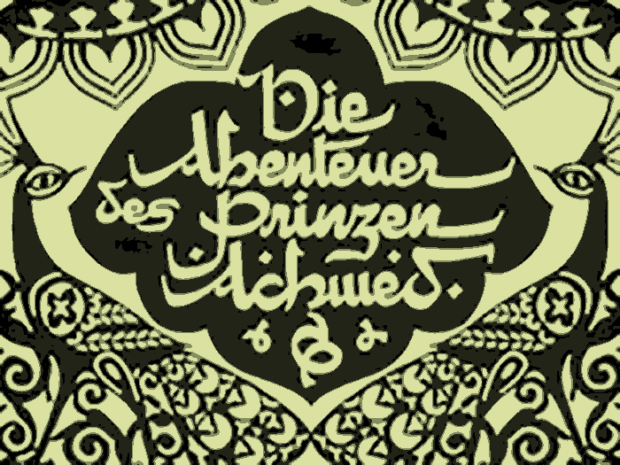
The Adventures of Prince Achmed is a silent film. But the latest DVD re-release features the original Wolfgang Zeller musical score that accompanied the film in its initial 1926 theatrical run.
The film is currently available to stream on Amazon Prime or you can purchase a DVD of the film for(Amazon link) $19 via Amazon.
Here are a few scenes of note to look for while you watch the film:
- During the course of his adventures, Prince Achmed eventually finds himself in a harem of girls. He excitedly starts kissing them all – but with each kiss, the girls get more and more jealous of each other. Their jealously soon leads to violence as they start fist-fighting with each other in an attempt to claim the handsome Prince for themselves.
- The Adventures of Prince Achmed may also be credited with utilizing the first “morph” technique on film. In one of the film’s most climatic scenes, the evil sorcerer and friendly Fire Witch engage in a combination aerial and aquatic battle which they continuously morph into a variety of dueling animals.
- My favorite scene of the film is when the Princess Pari Banu and her maidens put on feathered garments that allow them to fly to a stream to bathe. The graceful movements employed in this scene are like a beautiful animated ballet. But the most impressive part of this scene, is the shimmering and realistic silhouette ripples on the surface of the water. This scene had me in awe. It’s hard to believe that this film was made decades before computer animated was invented. The movement is so detailed and realistic that it had me in complete disbelief. You have to see it to believe it.
- Reiniger also made a cameo in the film. Although her face is never on camera, her hands can be spotted manipulating the silhouettes in several scenes.
Cast & Crew
- Lotte Reiniger Director, writer, animator
- Carl Koch Cinematographer
- Berthod Bartosch Animation
- Alexander Karadan Animation
- Walther Ruttmann Animation
The First Animated Movie Of All Time
“The Adventures of Prince Achmed” is a visually stunning achievement and still quite astonishing. Not only is The Adventures of Prince Achmed the oldest surviving animated movie and a piece of film history (two earlier short films were made in Argentina by Quirino Cristiani, but there are no surviving copies), but it’s a beautifully innovative and enchanting masterpiece. The film is so rich with wild imagination, you will forget your are watching paper cutouts and be amazed at how much expression Lotte Reiniger can evoke with her intricate hand-cut silhouettes.
As it continues to influence animators and captivate audiences, the enduring legacy of Reiniger’s work calls for a renewed appreciation of its cultural and historical significance.
Someday this film will get the recognition it richly deserves. Please share this article and tell someone else about The Adventures of Prince Achmed.

Frank Wilson is a retired teacher with over 30 years of combined experience in the education, small business technology, and real estate business. He now blogs as a hobby and spends most days tinkering with old computers. Wilson is passionate about tech, enjoys fishing, and loves drinking beer.

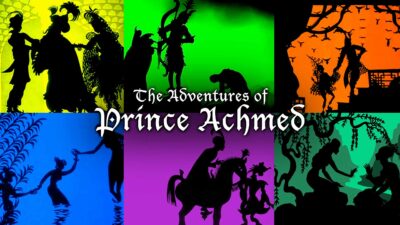
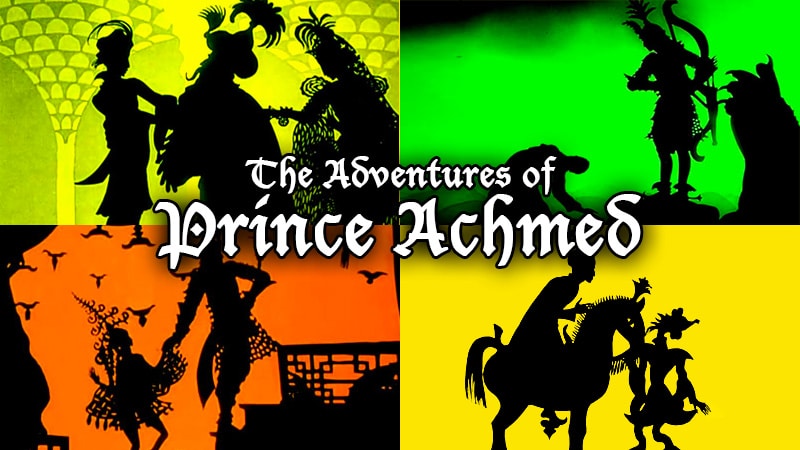









 The Surprising Story Behind The Creation Of The NBC Chimes
The Surprising Story Behind The Creation Of The NBC Chimes
Leave a Reply
You must be logged in to post a comment.